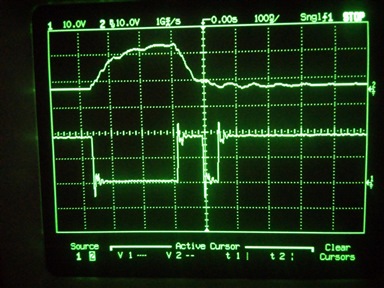Hi,
i've got a problem with the UCC20520: Depending on the load of channel A, channel B has a short off pulse after switching on. Position and length of the pulse does not depend on the duty cycle, the pwm frequency or the deadtime (it's possible to increase the deadtime so the off pulse is completely gone, as it's during the deadtime). The length of the off pulse however does depend on the load of channel A.
The problem is shown in picture above: On the bottom channel B is displayed (unloaded), the top shows channel A (loaded with two FETs, each with 7R5 gate resistor), duty cycle is just a few percent, deadtime is off. You can see when channel A switches on B switches off, but when A switches off again, B first switches on, but for a short pulse off again. The pulse becomes shorter or appears only sometimes by decreasing the load of channel A. I tried two different UCC20520, no difference. Could someone explain whats going here?
Best regards
Stefan


